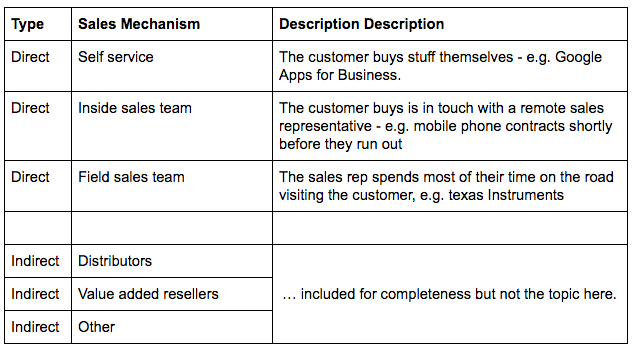Companies are usually founded to eliminate some type of problem the founders care about. The product the company makes solves that problem and in return for customers pay the company. In other words: a company sells a product.
How exactly the selling happens is extremely important to the company because it shapes the product and the company and consequently if the shareholders of the company are happy. But, it is very rarely explained what criteria to use when choosing a sales channel.
What follows is my best understanding these criteria. The focus is on the mechanisms more than on the exact numbers. As per usual, this is written fast and the result of my mistakes
Types of Selling for Product Managers
If you look at sales channels or method, there are a variety of methods. The grouping here is between direct and indirect. Indirect is anything where you are not selling directly to the customer but selling via some other party.
This is an example of self service
Direct sales (where you can engage with the customer directly) are divided into self service, inside sales team and a field sales team.
As an end-customer you deal mostly with self service type of sales environments - i.e. you do not talk to a human before purchasing.
A direct sales approach. Vorwerk vacuum cleaners.
Sometimes you will talk to a human on the phone, for example in the case of insurance or just before your mobile phone contract runs out - this is called inside sales team.
An outside sales team, i.e. people who visit you, are unfortunately not called outside sales teams but field sales team or field reps.
In private life I have only met field sales teams from Jehovahs Witness’ and expansive vacuum cleaners - the picture on the left is in fact from the company presentation of Vorwerk.
Vorwerk calls this "direct sales", I call it "field sales". The world ultimately does not care what you call things but how you understand them, so below you find the summary and description.
Types of Sales
Sales for Product Managers
We will take too approaches to get to the question. First, bottom up: i.e. starting from the cost of a Sales Person. Second, top down, understanding the same question from a company strategy perspective.
Bottom-up: what can you afford?
Before I go further here, I want to admit that I have limited experience selling. I have done both on the phone selling (really badly in my own start up), technical sales support in b2b and field sales but I am in no way an expert and have done each for less than a year.
A salesperson, both inside and field, is compensated through commission. The commission is determined by three things:
a) how many customer interactions do I have
b) what is the likelihood of a closed sales
c) what is the commission for the sales rep at each win
Let’s build the case backwards. Market rate for a high performing sales rep (regardless of inside or field) is 30k Euro fix and with another 40k variable on hitting the sales quota.
The math checks out like this:
How leads convert to commission
Leads: those are simply the amount of people the sales rep engages. For an inside rep I just assumed 30 leads per day and 20 working days. (That means your marketing needs to generate 600 fresh leads per month!). For field sales I assumed 10 leads per day (think about what product Vorwerk is selling).
Win Ratio and Wins: This is just the assumed ration from the interactions. It will depend on your product and qualification but 7% is rather high. Wins is just the the % of the leads.
Commission per Month on Target: as we have discussed before, we need to be able to pay a salesperson 3.3k$ commission per month (40k/12 Months) because that’s the the market rate for this type of labour.
Commission per Sales: this is simply 3.3k$ divided by the number of wins. That gives us how much commission we need to pay per win.
Check and Balances - Unit Economics
So, can we pay commission of 79$ or 238$? Well, this depends on your unit economics.
First, let’s assume we are selling software. Our target gross margin is 65% (See damodaran gross margin tables). That means producing and selling the product is <35% of the price.
If we set the cost of making the product and generating to 0 than the minimum price is: (commission) * (1/0.65). Obviously, that is a crazy assumption because we are not not spending any money on lead generation which will be key to maintain your sales team. Plus there is no budget for running the product, for example AWS fees, etc. This is a crazy assumption used to make the point.
Margin and product price
The answer:
In short, given the above assumptions if you product is below 122$ then inside reps make no sense. If you product is below 366$ then field sales makes no sense.
Cour product margin or conversion rates need to be higher or your sales people need to be cheaper to make it a good business.
But Customer Lifetime?
The lazy way out of this debate is to argue - once I have a customer, he will stay until infinity (e.g. in case of Netflix) or he will buy more stuff from me. That is a lazy argument and not valid until proven otherwise.
Top-Down Sales Strategies for Product Managers
This part begins with the interest of the shareholders. If you own the company yourself than obviously you can do whatever you want. But, let’s assume you are venture capital backed and need to grow a unicorn.
The product is still software, so we know the enterprise revenue to sale multiple. It is about 7 times revenue. To be a billion dollar company we need to do about 1 billion / 7 = 150m $ revenue.
The math looks like this:
Market Size for Product Managers
Let’s assume you can do 10% market share. Whatever you are selling, is the market size at 50$ for your product 30m customers? Be critical about this, even when you are selling something that costs 500k per year you will need 300 customers to achieve the returns you promise to achieve.
The rest of the math stays the same. Pay market rate and control for unit economics margin.
Conclusion:
Why are mobile phone contract sold with inside sales reps? Because the cost of a mobile phone contract is essentially 0 - except for the cost of the sales person. A 2 year contract at about 50$ a month is worth 1,200$ and the likelihood of buying is high because everybody needs one.
Also: make conscious decisions about your price and sales mechanism.





